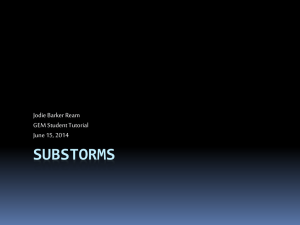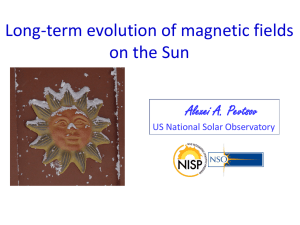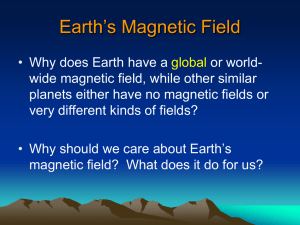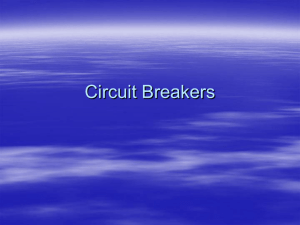Solar wind-magnetosphere-atmosphere coupling
advertisement
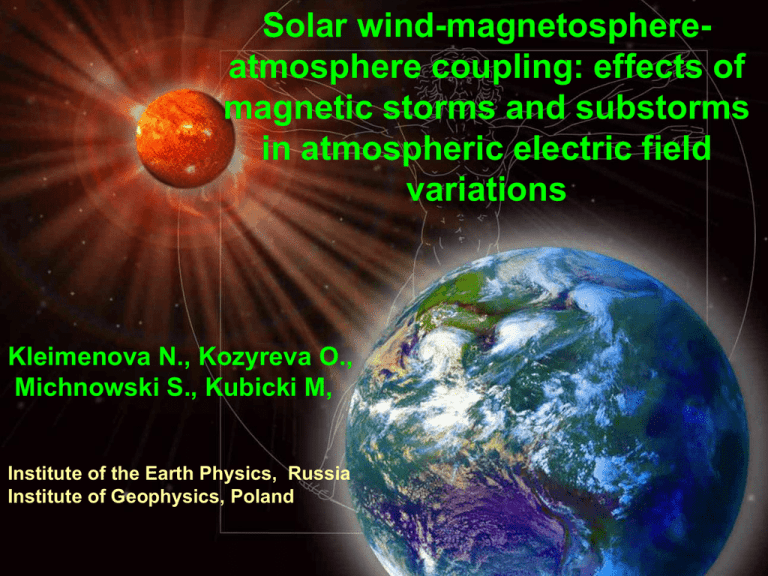
Solar wind-magnetosphereatmosphere coupling: effects of magnetic storms and substorms in atmospheric electric field variations Kleimenova N., Kozyreva O., Michnowski S., Kubicki M, Institute of the Earth Physics, Russia Institute of Geophysics, Poland Atmospheric electricity The global electric circuit The global electric circuit is controlled by the global thunderstorm activity. Thunderstorm activity draws current upward from the ground. The ionosphere disperses the current globally, and it leaks back to the surface. The important points: • 1. Despite being postulated since at least 150 years [Thomson (Lord Kelvin), 1860], the global electric circuit is still poorly quantified. • 2. Solar and magnetosphere activity influences due to ionosphere electric field disturbances may significantly control a global electric circuit state. • 3. The geoelectric circuit links weather and solar activity. It remains the open question whether this linkage is passive or involves active coupling. The aim of our investigations is to study an atmospheric electricity response to the magnetic storms and substorms. • Our studying was based on the observations of the vertical electric field (Ez) at two ground-based points: the middle latitude Swider station as well as at the polar latitude Hornsund station. • To avoid meteorological influences we used Ez data, obtained only under so called “fair weather” conditions, which request the absence of a rain, snow, fog, lower clouds, and wind velocity more 6 m/c. We could find not more than ~ 40-60 full days under “fair weather” condition in the year (i.e., ~12-15% of the total observations) MIDDLE LATITUDES Coordinates: obs. Swider (Poland) Geomagnetic Φ=47.8º, Λ=96.8º Local magnetic noon at ~10 UT Ez daily variations under Kp<2 Asia Africa Global thunderstorm activity Magnetic storm effect in the Ez variations • We have analyzed 14 magnetic storms in 20002004 observed under “fair weather” periods. It was typical that the main phase of the magnetic storms was accompanied by intense night-side magnetic substorms. • The storm-time Ez anomalies are better manifested by comparing the recorded data with Ez daily variations obtained under the quiet magnetic conditions (at least Kp<2). Asia Ez Ez – Ez(quiet) Day side BEL Night CMO SOD Africa BEL CMO SOD Results • For the first time the magnetic storm effect was found in the mid-latitude Ez variations. • Our study showed that during the main phase of a magnetic storm a strong daytime negative Ez deviations were observed at middle latitudes simultaneously with magnetic substorm developing at night side of the auroral zone under any local midlatitude magnetic perturbations. • The considered Ez deviations could be associated with the interplanetary electric field enhancement and it deep penetration into the magnetosphere. • Another plausible reason could be related to the common ionosphere conductivity increasing due to substorm energetic electron precipitation because the high-latitude ionosphere is an important part of the global atmospheric electric circuit. Two examples of the Forbush decrease influence to the Ez changes Dst AE Forbush decrease averaged Ez level Forbush Ez level The strong Ez depletion in the days of Forbush decrease development is seen. In the polar regions, the interaction of the solar wind and the Earth's magnetic field causes the two-cell convection patterns in the polar ionosphere. Solar influence on the atmospheric electric field differs between middle and polar latitudes. _ + The polar cap potential can produce significant vertical electric fields (Ez) at the ground level. Obs. Hornsund (Spitsbergen) COORDINATES Φ=74º, Λ=110.5º HOR Substorm effects in Ez at polar latitudes (obs. Hornsund) morning night morning night 74º 64º Two examples of a negative Ez deviation during the night substorms and a positive Ez deviation during the morning substorms Global structure of high latitude plasma convection during the considered morning substorms at Scandinavian meridian according to the SUPERDARN data Global structure of high latitude plasma convection during the considered night-time substorms at Scandinavian meridian according to the SUPERDARN data The auroral oval location during the considered substorm Ez X CONCLUSION Magnetic storms and substorms, caused by solar wind and interplanetary magnetic field disturbances, could influence to the global electric circuit state via changing of ionosphere conductivity due to particle precipitations or via cosmic rays, or via the direct interplanetary electric field penetration into magnetosphere, or via the polar cap convection changes. Thus, the variations in the atmospheric electricity both in middle and polar latitudes represent one of the final stage of the solar wind-magnetosphere-atmosphere coupling. THANK YOU FOR ATTENTION! My coauthors: S. Michnowski, O Kozyreva, M.Kubicki Magnetic storm initial phase SC Ez Pd Np HOR Vx B Bx B X B By Bz SOD Bz IMF = +36 nT



